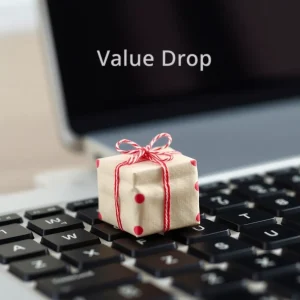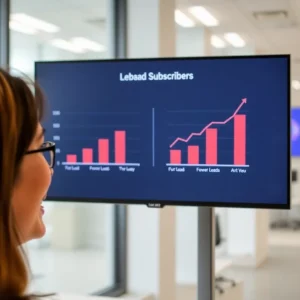Cold Lead Follow‑Up Strategies
11 Smart Moves to Convert Hesitant Prospects

So you’ve got a list of leads that went radio‑silent. Maybe they downloaded your checklist, signed up for a webinar, or simply clicked “maybe later”. They’re the “cold leads”, and yes, you can absolutely warm that list up with smart follow‑up.
In this post you’ll discover 11 cold lead follow‑up strategies that work, along with examples you can customize, plus how these techniques tie into building your “Internet Profit Success”.
Because turning cold leads into paying customers? That’s one of the fastest ways to move toward your version of online success.
1. Reference Previous Contact (Reset the Context)
One of the best cold lead follow‑up strategies is simply reminding folks exactly how you met, or how they got on your list. It resets the context, shows you weren’t just blasting “Hey buy now” into the void, and brings the conversation back to something they recognise. For example: “Based on your download of my planning guide last week…” or “When you joined our webinar on email subject lines…” That kind of opener helps jog their memory, builds connection, and sets up your next move.
Why it matters: If you skip this, the lead might have no idea who you are, what you offered, or why you’re emailing them. And that means lower trust, lower reply rate, higher “meh” factor.
Tip: Use something genuine and specific: where they came from, what they downloaded, what their pain point was.
Example opening line:
“Based on your download of my checklist on ad‑copy tweaks, I thought you’d appreciate this quick extra tip…”
You’re showing you paid attention, you’re following up with value, and you’re not just cold‑selling.

2. Share a Quick Value Drop
When a lead is cold, asking for the sale right away is like showing up at someone’s door asking to hang drywall before you’ve even introduced yourself. Instead, a great follow up technique for cold leads is to give micro‑value: a tiny tip, a slight fix, something actionable but small. No ask yet. Just helpful.
Example: “Try this hack to double your email open rates.” You send a one‑line subject‑line tip, they grin, they think “hey this person gets it”, and you warm the relationship.
Why it works: It builds goodwill, demonstrates your expertise, and shifts the dynamic from “marketer chasing lead” to “helper adding value”.
Actionable prompt: Send a short message or email: “Here’s one small tweak you can test this week…”
Example line:
“Here’s a quick value drop: if your ad click‑through rate is under 2 %, try swapping your primary image with a human face + red arrow, I’ve seen that nudge it up 15 % in 48 hrs.”
3. Ask a Simple Question
Interaction matters. When you send value, following up with a simple question invites a response. That’s one of the smartest follow‑up techniques for cold leads: asking something like “Did that make sense?” or “Did you try it yet?” A yes/no or easy response lowers the barrier.
People hate long forms, heavy replies, they’ll reply to “Yes, I tried it” more easily than “Tell me how the whole funnel is working.”
Why it matters: It opens a conversation, makes the lead feel seen, and begins engagement rather than broadcasting.
Prompt: After you drop the value tip, ask: “Was this useful to you?” or “Did you give this a spin?”
Example question:
“Did that little tweak help you bump your open rate at all?”
4. Offer a Quick Consultation (Friendly, No‑Pressure)
Once you’ve started building some connection, offering a short chat or review helps. But it’s crucial. Keep it about helping, not pitching. “Want to connect for 15 minutes to fix your funnel’s first step?” is much more inviting than “Buy my high‑ticket coaching now”. This is a core piece of the cold lead follow‑up strategies arsenal. It says: “Let’s get you unstuck, free for now”.
Why it works: Live or semi‑live one‑on‑one time gives huge value, builds trust, and people respond because it feels personal.
Action step: Offer a 15‑minute slot, explain what you’ll cover, emphasise no pressure.
Example 2‑line email:
“Hi [Name], I noticed you downloaded the funnel checklist last week. If you like, we can hop on a 15‑minute call this week to look at your funnel’s first step and map one tweak you could make.
Would you like me to pull up some time options?”
5. Send a Success Story
Social proof is incredibly persuasive. One of the more memorable follow up techniques for cold leads is to share someone else’s success, ideally someone relatable to your lead. “Here’s what one of our members did after using the tip you downloaded…” It helps the lead see “huh, maybe this could actually work for me too”.
Why it works: Humans trust humans. When they see someone similar making progress, they feel more confident.
Action step: Craft a mini case study or testimonial (keep it brief). Show the challenge → the action → the result.
Example success story:
“Client X was stuck with zero list growth. They used the ad‑image hack from our guide and got +500 new subscribers in 30 days. That became their launch fuel.”
Then you follow up: “Here’s how they did it…”
You tie this back to your own lead: “Since you downloaded the same checklist, I thought you’d like to know what others are doing.”

6. Provide a “Behind‑the‑Scenes” Update
People like being included. One of the most human‑sounding cold lead follow‑up strategies is to show what you’re doing, behind the scenes. It builds authenticity and makes you more than just a brand. “Here’s a snapshot of what I’m working on… this tip may help you too.”
Why it works: It lowers the barrier, makes the interaction feel like a peer conversation rather than a sales pitch.
Action step: Send a short update: “I just finished working on…” or “Here’s what I discovered today…”
Example note:
“Hey, I just wrapped the new mini‑guide on subject‑lines. One thing I uncovered: changing the first word to a question boosted replies by 12 %. Thought you might like that if you’re still working on your sequence.”
7. Create a Limited Bonus Opportunity
Scarcity works (but subtly!). Among your cold lead follow‑up strategies: offer a bonus, maybe a video, checklist, live audit, but only for the first few who respond. It’s a gentle nudge. Not “BUY NOW”, but “Hey if you want extra help, I’ve got something for a few people”.
Why it works: Makes people pay attention (“Oh, there’s a bonus window”), prompts action.
Action step: Announce the bonus, specify the limitation (“first 5 responses this week”).
Example invite:
“I’m offering a bonus live audit this week to the first three people who respond, we’ll hop on a call, look at your funnel dashboard together and find one tweak you can implement by Friday.”
8. Use a Video Reply
We live in a video‑first world. One of the standout follow‑up techniques for cold leads: record a short screen‑capture video (60 seconds) walking through a tip, voila, you just personalised the interaction and added value in a different format.
Why it works: Video adds personality, clarity, and breaks the monotony of plain text email. Also it builds trust faster.
Action step: Record a quick Loom or similar. Then send a script or guide for what to say.

Example script:
“Hi [Name], thanks again for downloading the guide. I recorded a quick 60‑second screen showing how you can change your ad image in five minutes to boost click‑through. Check it out… Let me know if this makes sense and I’ll send you the editable template.”
Now that’s a hook.
9. Re‑share Original Content
Sometimes the lead missed or forget your earlier content. One of the more subtle but effective techniques. Pick a past blog post, tip, or piece you created, and share it again with a personalised note: “Since you downloaded our guide, I thought you’d enjoy this post… still super relevant.”
Why it works: You’re giving value by curating content, not just trying to sell. And you’re reminding them you exist, gently.
Action step: Choose a relevant older post, link it, add a personal line.
Example note:
“Hi [Name], I saw you downloaded the funnel checklist last month, here’s a post I wrote early this year: ‘5‑minute funnel fixes you can implement tonight’. Thought it might help you plug in one more tweak.”
10. Offer a Challenge Invite
Challenges are low‑commitment, fun, and effective at re‑engaging. Among your cold lead follow‑up strategies, you can invite them to join a “5‑day email subject line challenge” or “3‑day funnel refresh challenge”. Framed as “just five minutes a day” it minimizes barrier and builds momentum.
Why it works: Leads feel like part of a group, it’s temporary, easy to join, outcome‑oriented.
Action step: Create a simple invite, emphasise the short time commitment, highlight benefit.
Example email invite:
“Hey [Name], I’m running a free 3‑day ‘Subject Line Boost Challenge’ starting Monday. Just five minutes each day. No cost, no heavy lifting. If you’d like to join, here’s the link…”
By joining, they start engaging, you warm them up, you build trust, and that leads toward conversion.
11. Ask for Feedback on Your Offer
Here’s a less‑used but very effective tactic: you ask the cold lead what they think of the resource you sent, or what would make it better. It’s disarming, human, and can spark a reply. Among your “convert cold leads into customers” tactics, this is one that leads to meaningful conversation.
Why it works: It shifts the dynamic from “marketer pushing” to “someone seeking input”. It gives the lead a voice, which builds connection.
Action step: Send a brief email: “What would make this guide better for you?” or “How did the checklist work for you? What could have helped more?”
Example:
“Hi [Name], you downloaded my checklist last week. I’d love your feedback: what did you like? What didn’t quite hit the mark? If you tell me one thing that could’ve made it better for you, I’ll improve it, and I’ll send you a bonus in return.”
Bringing It Together: From Cold Inbox to Conversion
At this point you’ve seen 11 solid follow‑up techniques, each one part of a strategy to warm up cold leads rather than slam them with a hard ask. Because that’s exactly what people often resist: the pushy pitch. But when you focus on value, conversation, trust, and small‑step action, you build the path toward actual conversion.
And that ties directly into your “Internet Profit Success”: by turning your cold leads into customers (or at least active responders), you’re moving toward monetising your list, generating momentum, and creating a system that builds profitability online.
Key reminders:
Use the main keyword cold lead follow‑up strategies in headings and body.
Sprinkle related phrases like follow up techniques for cold leads, convert cold leads into customers, cold lead follow up email templates naturally (don’t stuff them).
Use headings (H2, H3) that incorporate your keyword. For example: “Cold Lead Follow‑Up Strategies #4: Offer a Quick Consultation”.
Keep paragraphs short, readable (people scan).
Insert some humour, friendly tone: e.g., “Don’t worry, you’re not about to send 27 follow‑ups in one hour yelling ‘BUY NOW’.”
Make sure each section adds value and demonstrates how the tactic works, why it works, and gives an example.
Bonus Tips for Maximising These Follow‑Up Strategies
Segment your leads: Cold leads are not a single monolith. Some downloaded a freebie yesterday, others signed up two months ago and never opened an email. Tailor your follow‑up accordingly.
Track your metrics: Which of the 11 tactics gets better replies? Which converts more? Over time you’ll refine what works for your audience.
Personalise where possible: The more you can reference their name, download, behaviour, the more the follow‑up feels genuine.
Be consistent but not annoying: Follow‑up is about cadence. You want to stay present without being the clingy ex.
Use templates + variation: Create cold lead follow up email templates (one for each tactic) and then vary them so they don’t feel robotic.
Align timing with lead’s journey: If someone just downloaded yesterday, opening with “Hey how did you find the guide you grabbed two months ago?” won’t land. Match timing.
Tie to value, not just offer: Each tactic above emphasises giving value, building trust, before listing the big ask. That’s the inversion of “pitch first, trust never built”.

Final Thoughts
Warm‑up is an art and a process. Cold leads don’t become customers overnight, usually. But with the 11 cold lead follow‑up strategies above, you’ve got a menu of powerful, human‑centred options to lean into. Each one builds trust, opens conversation, offers real help, and positions you as someone who gets the struggle. As you do this, you’re also building toward that bigger idea of Internet Profit Success, by turning leads into relationships, and relationships into revenue (without being sleazy).
So pick three of these tactics this week, apply them to your cold‑list segment, track how they respond, iterate your templates, and keep at it. The leads are already there; it’s your follow‑up flow that’s going to unlock the potential.
Here’s to warming up those cold leads and turning them into customers. You’ve got this.
For faster learning watch these 5FREE VIDEOS
